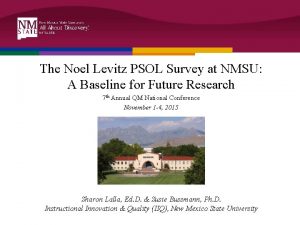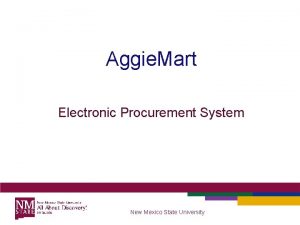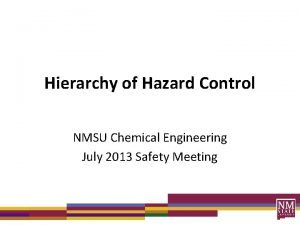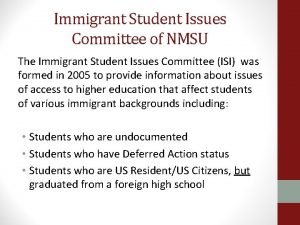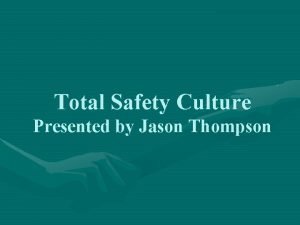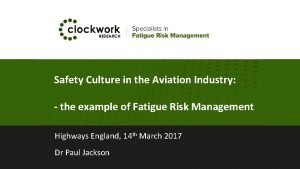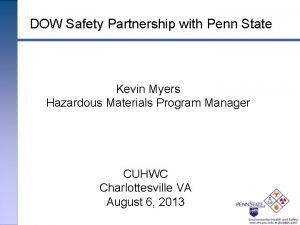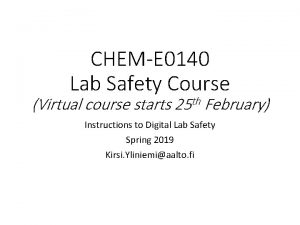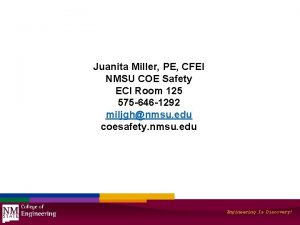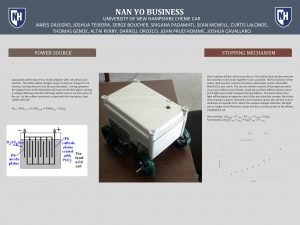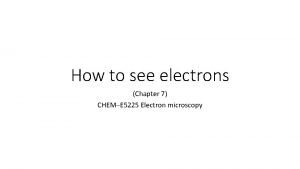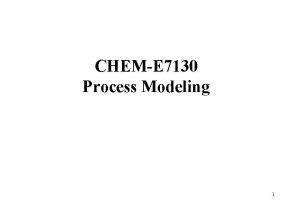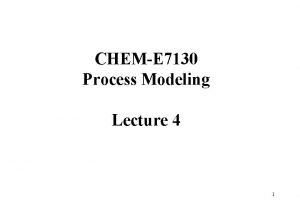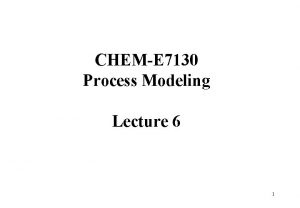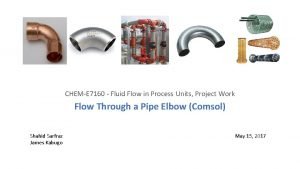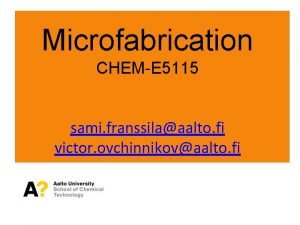Continued Development of the NMSU CHEME Safety Culture





























- Slides: 29

Continued Development of the NMSU CHEME Safety Culture Monthly Safety Meeting December 13, 2013


Incident at Texas Tech • On January 7, 2010, a graduate student within the Chemistry and Biochemistry Department at Texas Tech University (Texas Tech) lost three fingers, his hands and face were burned, and one of his eyes was injured after the chemical he was working with detonated. • http: //www. csb. gov/videos/experimenting with danger/ – 11: 11 through 20: 30

Investigation at Texas Tech • The CSB investigated and found systemic deficiencies within Texas Tech that contributed to the incident: – physical hazard risks inherent in the research were not effectively assessed, planned for, or mitigated; – lacked safety management, accountability, oversight; – previous incidents with preventative lessons were not documented, tracked, and formally communicated.

Beyond Texas Tech • While vast references, standards and guidelines have been developed to describe and promote different types of hazard evaluation methodologies in an industrial setting, similar resources that address the unique cultural and dynamic nature of an academic laboratory setting have not been generated.

Beyond Texas Tech • Universities choosing to use OSHA’s Lab Standard (29 CFR 1910. 1450) as guidance for developing a plan to mitigate chemical hazards need to understand that the standard was not created to address physical hazards of chemicals, but rather health hazards as a result of chemical exposures.

§ 1910. 1450 Occupational exposure to hazardous chemicals in laboratories. (a) Scope and application. (1) This section shall apply to all employers engaged in the laboratory use of hazardous chemicals as defined below. (2) Where this section applies, it shall supersede, for laboratories, the requirements of all other OSHA health standards in 29 CFR part 1910, subpart Z, except as follows: (i) For any OSHA health standard, only the requirement to limit employee exposure to the specific permissible exposure limit shall apply for laboratories, unless that particular standard states otherwise or unless the conditions of paragraph (a)(2)(iii) of this section apply. (iii) Where the action level (or in the absence of an action level, the permissible exposure limit) is routinely exceeded for an OSHA regulated substance with exposure monitoring and medical surveillance requirements, paragraphs (d) and (g)(1)(ii) of this section shall apply.

• • • • • 1910 Subpart Z - Toxic and Hazardous Substances records. § 1910. 1000 Air contaminants. • § 1910. 1001 Asbestos. • § 1910. 1002 Coal tar pitch volatiles; interpretation. . . • § 1910. 1003 13 Carcinogens (4 Nitrobiphenyl, • etc. ). • § 1910. 1004 alpha Naphthylamine. • § 1910. 1006 Methyl chloromethyl ether. • § 1910. 1007 3 Dichlorobenzidine (and its salts). • § 1910. 1008 bis Chloromethyl ether. • § 1910. 1009 beta Naphthylamine. • § 1910. 1010 Benzidine. • § 1910. 1011 4 Aminodiphenyl. • § 1910. 1012 Ethyleneimine. • § 1910. 1013 beta Propiolactone. • § 1910. 1014 2 Acetylaminofluorene. • § 1910. 1015 4 Dimethylaminoazobenzene. • § 1910. 1016 N Nitrosodimethylamine. • § 1910. 1017 Vinyl chloride. § 1910. 1018 Inorganic arsenic. • § 1910. 1020 Access to exposure/medical § 1910. 1025 Lead. § 1910. 1026 Chromium (VI). § 1910. 1027 Cadmium. § 1910. 1028 Benzene. § 1910. 1029 Coke oven emissions. § 1910. 1030 Bloodborne pathogens. § 1910. 1043 Cotton dust. § 1910. 1044 1, 2 dibromo 3 chloropropane. § 1910. 1045 Acrylonitrile. § 1910. 1047 Ethylene oxide. § 1910. 1048 Formaldehyde. § 1910. 1050 Methylenedianiline. § 1910. 1051 1, 3 Butadiene. § 1910. 1052 Methylene Chloride. § 1910. 1096 Ionizing radiation. § 1910. 1200 Hazard communication. § 1910. 1201 Retention of DOT markings, …, labels. § 1910. 1450 Occupational exposure to hazardous chemicals in laboratories.

CSB Key Lessons from Texas Tech: 1. Academic institutions modeling their laboratory safety management plan after OSHA’s Lab Standard (29 CFR 1910. 1450) should ensure that all safety hazards, including physical hazards of chemicals, be addressed. 2. Academic institutions should ensure that practices and procedures are in place to verify that research specific hazards are evaluated and mitigated.

CSB Key Lessons from Texas Tech: 3. Comprehensive guidance on managing the hazards unique to laboratory chemical research in the academic environment is lacking. Current standards on hazard evaluations, risk assessments, and hazard mitigation are geared toward industrial settings and are not fully transferable to the academic research laboratory environment. 4. Research-specific written protocols and training are necessary to manage laboratory research risk.

CSB Key Lessons from Texas Tech: 5. An academic institution’s organizational structure should ensure that the safety inspector/auditor of research laboratories directly report to an identified individual/office with organizational authority to implement safety improvements. 6. Near-misses and previous incidents provide opportunities for education and improvement only if they are documented, tracked, and communicated to drive safety change.

Causation • With any serious event, it is all too common for attention to be focused on the actions and decisions of the individuals involved in the immediate activities preceding the event. • Modern accident causation theory recognizes that incidents are not the result of a single malfunctioning piece of equipment or the erroneous actions of one person, but instead are the result of a number of failures and deficiencies at many levels within an organization and its technical community.

Theory of accident causation: Swiss cheese model Within the context of an academic institution, this model depicts a series of safety layers (or system defenses) capable of preventing an incident. The holes represent gaps within each system where failure could occur. If a number of failures

Causation at Texas Tech • Through review of evidentiary records, interviews, and post incident observations, the CSB concluded that each layer of safety management within the institution had deficiencies that contributed to the January 2010 Texas Tech incident. • The CSB also identified several gaps beyond the university itself where safety management and practices of the researchers could have been influenced to aid in prevention, including the grant funding agency, the existing laboratory safety regulations, and good practice guidance.

CSB Causation at Texas Tech • Physical hazards of the energetic materials research were not effectively assessed and controlled; • TT lab safety management program was modeled after 29 CFR 1910. 1450; thus did not address physical hazards of chemicals; • Comprehensive hazard evaluation guidance did not exist; • Previous TT lab incidents with preventative lessons were not always documented, tracked, and formally communicated; • The research granting agency prescribed no safety provisions specific to the research work being conducted at TT at the time of the incident, missing an opportunity for safety influence; and

The Grant Agency’s role • Department of Homeland Security is one of 19 federal agencies that collectively provide over $25. 3 billion to academic institutions for scientific research (NSF, 2009), but not all of these agencies choose to include safety requirements or stipulations within their grant applications and cooperative agreements with researchers. DHS did not have safety provisions specific to the energetic materials research being conducted by Texas Tech within its cooperative agreement with NEU. • After the incident, the Office of University Programs in DHS added a new safety condition to the 2011 cooperative agreements with all universities funded by any of the DHS Centers of Excellence. This safety condition, the Research Safety Plan, has requirements that a contractor include these conditions in all sub

Changes to DHS awards: • Possible research hazards associated with the types of research to be conducted under the award are identified; • Research protocols or practices conform to generally accepted safety principles applicable to the nature of the research; • Recipient’s processes and procedures – comply with the applicable protocols and standards; – prevent unauthorized activities conducted in association with this award; • Faculty oversees student researchers; • Research safety education and training to develop a culture of safety are provided; • Security access control, where applicable; and • Independent review by subject matter experts of the

CSB Key Lessons from Texas Tech: 5. An academic institution’s organizational structure should ensure that the safety inspector/auditor of research laboratories directly report to an identified individual/office with organizational authority to implement safety improvements.

Texas Tech Organization Hierarchy

Texas Tech Organization Hierarchy

NMSU Organization Hierarchy

The NMSU CH E Safety Culture • The development of the department’s safety culture is dynamic, with changes driven by information gathered about recent incidents and changes to regulations. • The current state of our safety awareness is good, though there is always room for improvement. • Thank you for your attention to safety in CH E.

Resources to be added to Shires • Prudent Practices in the Laboratory, Handling and Management of Chemical Hazards – THE NATIONAL ACADEMIES PRESS Washington, D. C. www. nap. edu, Copyright © National Academy of Sciences. • Identifying and Evaluating Hazards in Research Laboratories – Guidelines developed by the Hazards Identification and Evaluation Task Force of the American Chemical Society’s Committee on Chemical Safety – Copyright 2013 American Chemical Society

Hydrogen Explosion Incident http: //munews. missouri. edu/news-releases/2010/0709 -investigation-of-schweitzer-hall-explosion-complete/ • COLUMBIA, Mo. — Officials from the University of Missouri have completed an investigation into the cause of the explosion at Schweitzer Hall that occurred on Monday, June 28, 2010. • The explosion occurred in the laboratory of Judy Wall, professor of biochemistry, during a routine setup of a microbiological anaerobic growth chamber. Wall and her team of researchers study anaerobic bacteria, or bacteria that cannot live in the presence of oxygen. The bacteria are able to convert toxic metals, such as uranium and other heavy metals, to less toxic forms.

Investigation of Schweitzer Hall Explosion • Wall’s team studies the bacteria in chambers that are roughly 2 cubic meters in volume. • Standard operating procedures for establishing the anaerobic environment calls for the use of nitrogen to fill the chamber. Then, small amounts of hydrogen are introduced into the chamber to remove any remaining oxygen by combining to form water. Prior to the explosion, hydrogen was prematurely introduced into the chamber and reached an explosive level. Investigators concluded that the gas was ignited by a source inside the chamber.

Investigation of Schweitzer Hall Explosion • Two factors contributed to hydrogen being introduced prematurely into the chamber: 1. Following a check for leaks in the hydrogen gas lines, the valve for the hydrogen cylinder was inadvertently left open. 2. The laboratory was using a gas line with a “T connection” that normally included a toggle switch used to prevent nitrogen and hydrogen from being simultaneously introduced into the chamber. However, a T connection without the toggle switch was temporarily being used; thus both nitrogen and hydrogen entered the chamber simultaneously.

Investigation of Schweitzer Hall Explosion • To prevent such accidents in the future, investigators recommended the following actions: – Replace the use of pure hydrogen with a 95: 5 mixture of nitrogen and hydrogen. – Following a check of gas lines for leaks, all gas cylinders should be closed and only reopened as needed. – Use of T connections between gases should be eliminated. – Investigate use of hydrogen and/or oxygen sensors that could withstand a corrosive atmospheric environment. – Give refresher training to all laboratory personnel. – Review training, guidance materials, and inspection procedures. – Review compressed gas cylinder storage area to ensure appropriate safety procedures are in place and look for improvements.

Investigation of Schweitzer Hall Explosion • Investigators believe several factors helped mitigate damage and allowed normal building activities to resume quickly, including: – Wall’s laboratory group was well organized and clean, minimizing secondary impacts from the explosion. – Emergency information about laboratory hazards was posted outside the door for emergency responders. – Emergency Action Plan had identified exit routes and building occupants evacuated in a timely manner. – Utilities had been reconfigured for the building, allowing maintenance workers to cut off utility service to the affected laboratories, while keeping service to the rest of the building. – Cooperation among the Columbia Fire Department, MU Campus Facilities, MU Environmental Health and Safety, and the MU Police Department was excellent. A history of exercises and meetings have strengthened relationships and cooperation.

Have a safe holiday! Don’t work alone in the labs.
 Nmsu irb
Nmsu irb Nmsu blackboard
Nmsu blackboard Study abroad nmsu
Study abroad nmsu South campus office
South campus office Nmsu purchasing
Nmsu purchasing Hazard control methods
Hazard control methods Ict nmsu
Ict nmsu Nmsu digital measures
Nmsu digital measures Nmsu scholar dollar
Nmsu scholar dollar Popular culture example
Popular culture example Sociologists define a symbol as
Sociologists define a symbol as Batch culture vs continuous culture
Batch culture vs continuous culture Continuous culture and batch culture
Continuous culture and batch culture Collectivistic cultures
Collectivistic cultures Indian vs american culture
Indian vs american culture Stab and stroke culture
Stab and stroke culture Folk culture and popular culture venn diagram
Folk culture and popular culture venn diagram Sub culture group
Sub culture group Folk cultures are spread primarily by
Folk cultures are spread primarily by Stab culture and stroke culture
Stab culture and stroke culture Folk culture and popular culture venn diagram
Folk culture and popular culture venn diagram Inert organizational culture
Inert organizational culture Stroke culture method
Stroke culture method Lawn culture
Lawn culture Characteristics of quality culture
Characteristics of quality culture Surface culture deep culture and esol
Surface culture deep culture and esol Dr jason thompson
Dr jason thompson Safety culture in aviation industry
Safety culture in aviation industry John asbury penn state
John asbury penn state Generative safety culture in aviation
Generative safety culture in aviation
